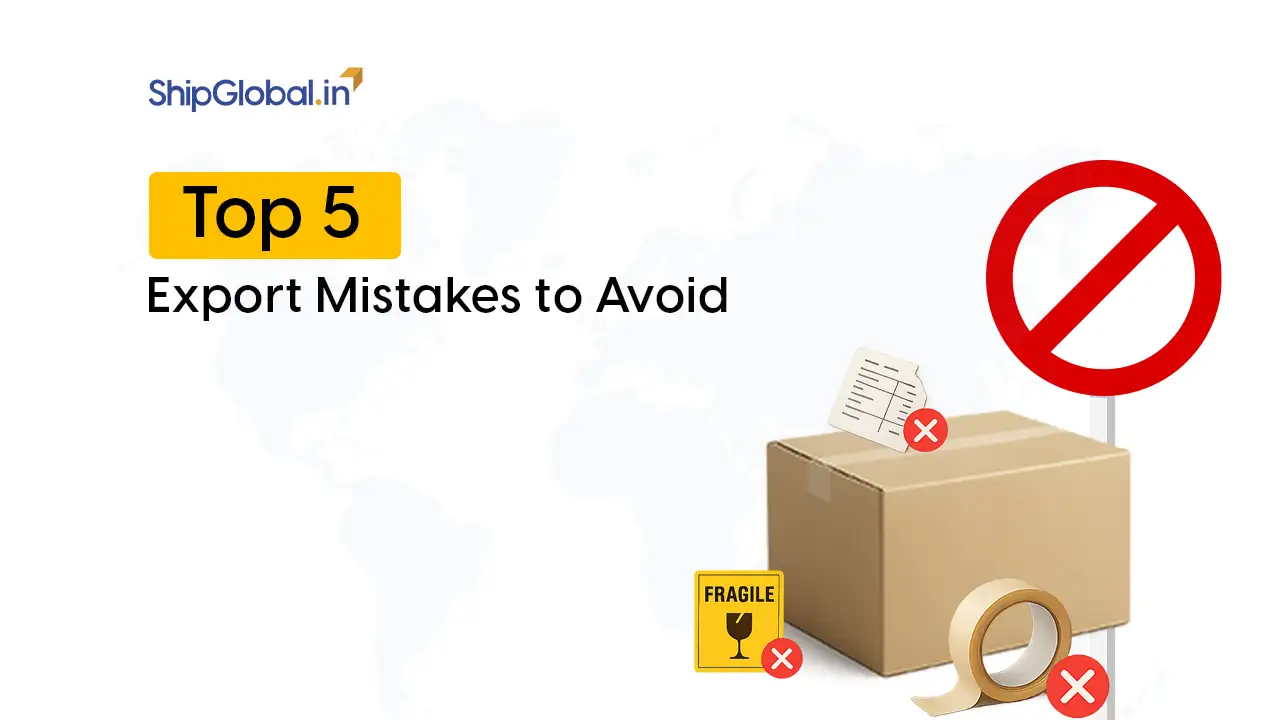If you’re exporting goods from India through courier services, you’ve probably heard about CSB-IV and CSB-V forms. These terms might sound technical, but they play a vital role in how your shipment gets cleared by customs. Understanding the difference between CSB-IV and CSB-V can help you stay compliant, avoid delays, and streamline your export process.
In this blog, let’s break down what these courier shipping bills mean, how they differ, and when you should use each type.
What is a Courier Shipping Bill in India
Before we dive into CSB-IV vs CSB-V, let’s quickly understand what a Courier Shipping Bill is.
When goods are exported from India via a courier (like FedEx, DHL, or India Post), a shipping bill must be filed with Indian Customs. This bill contains essential details about the shipment, such as the sender, recipient, description of goods, value, and purpose of export.
Unlike cargo exports where a standard Shipping Bill (SB) is used, the courier mode follows a different documentation system known as Courier Shipping Bills (CSBs). The CSB meaning refers to a special type of shipping bill used for exports via courier mode. These are categorized into CSB-I to CSB-V, depending on the nature and value of the goods.
What is CSB 4
CSB-IV (Courier Shipping Bill-IV) is used for non-commercial exports—think of gifts or product samples. It’s a declaration to customs about what you’re shipping out of India, and it’s designed to keep things simple for smaller, low-value exports.
When to Use:
- When sending gifts, samples, or personal-use items.
- Shipment value should be up to ₹25,000.
- The goods are not intended for sale or commercial use.
Key Features:
- Purpose: Non-commercial export
- Value limit: Up to ₹25,000
- IEC (Importer Exporter Code): Not required
- GST and HSN details: Not required
- Export incentives: Not applicable
- e-BRC (Electronic Bank Realisation Certificate): Not issued
Ideal for:
- Individuals sending gifts abroad
- Businesses sending product samples or testing foreign/new markets
- Low value shipments
What is CSB 5
CSB-V (Courier Shipping Bill-V) is used for commercial exports where the exporter wants to claim government benefits, such as duty refunds or tax exemptions under schemes like MEIS. This is ideal for high value courier exports (up to ₹10,00,000).
When to Use:
- When exporting goods for sale or business purposes.
- Shipment value is up to ₹10,00,000.
- The sender is a registered exporter or business.
Key Features:
- Purpose: Commercial export
- Value limit: Up to ₹10,00,000
- IEC: Mandatory
- GST and HSN details: Required
- Export incentives: Eligible (e.g. GST refund)
- e-BRC: Issued
Ideal for:
- Registered exporters/businesses
- Incentivised exports
- Exporters selling goods on platforms like Amazon, Etsy, or Shopify (eCommerce sellers)
MEIS Claim / Eligibility Under CSB V
One of the major advantages of using CSB V (Courier Shipping Bill V) for your exports is the ability to claim benefits under the Merchandise Exports from India Scheme (MEIS).
MEIS is a government initiative designed to incentivize Indian exporters by offering duty credit scrips — essentially financial rewards that can be used to offset customs duties or transferred to other importers. These rewards help reduce overall export costs and improve global competitiveness.
However, to successfully claim MEIS through CSB V, your shipment must satisfy specific eligibility criteria defined by the Directorate General of Foreign Trade (DGFT).
To claim MEIS through CSB V, your shipment must meet the following conditions:
- Within Permitted Value Thresholds: The shipment should fall under the eligible value range as defined by the policy (MEIS).
- Foreign Exchange Transaction: The export must involve a realized foreign currency transaction – in other words, payment must be received in foreign exchange.
- Product Categories: Only specific product types are eligible for MEIS when shipped via courier. Some of these include handicrafts, books and periodicals, handloom products, toys, leather footwear, and customized fashion garments.
If your shipment checks all these boxes, you can file under CSB V and apply for MEIS benefits, helping reduce your export costs and improving your overall margins.
CSB-IV and CSB-V Key Differences: A Quick Comparison Table
| Feature | CSB-IV | CSB-V |
|---|---|---|
| Purpose | Non-commercial (gifts/samples) | Commercial (for sale/export) |
| Value Limit | Up to ₹25,000 | Up to ₹10,00,000 |
| IEC Required | No | Yes |
| GST and HSN Codes | Not required | Mandatory |
| Export Incentive Eligible | No | Yes |
| e-BRC Issued | No | Yes |
| User Type | Individuals, sample senders | Registered exporters, e-com businesses |
Benefits of Using the Right Courier Shipping Bill
CSB-IV:
- Quick and easy: Ideal for sending small-value items abroad without needing business registration.
- No paperwork hassle: No IEC or GST compliance needed.
- Budget-friendly: Simple and cost-effective for personal shipments.
CSB-V:
- Business-compliant: Meets all legal requirements for commercial exports.
- Supports growth: Helps businesses expand into international markets.
- Tax benefits and government incentives: Enables claiming of GST refunds and use of export incentives.
- e-BRC: Useful for financial records and compliance with foreign exchange laws.
Why Does This Matter
Whether you’re a business or an individual, choosing the correct type of export shipping bill in India is essential for:
- Ensuring fast customs clearance
- Staying compliant with DGFT and Customs rules
- Receiving necessary export documentation (like e-BRC)
- Avoiding penalties or shipment returns
Which Courier Shipping Bill Should You Use
- If you’re sending gifts or free samples without expecting payment, CSB IV is your best friend.
- If you’re shipping products for sale and want to claim export benefits, CSB V is the right choice.
Choosing the correct courier shipping bill type helps you stay compliant, avoid customs delays, and optimize your export strategy.
Final Thoughts
Understanding the CSB-IV vs CSB-V difference may seem like a small thing, but it plays a big role in how your exports are handled. Whether you’re a seller on an international marketplace, a manufacturer exporter, or just sending a birthday gift to someone overseas, using the correct Courier Shipping Bill ensures smooth and legal export operations.
So next time you are shipping out a parcel, remember: It’s not just about packing it up—it’s about filing the right paperwork too.
Happy Shipping!
FAQs
CSB-IV is used for non-commercial exports like gifts and samples with a value up to ₹25,000. CSB-V is for commercial exports with a value up to ₹10,00,000 and requires proper documentation like GST and IEC.
Yes, an IEC is mandatory for CSB-V since it covers commercial exports. It is not required for CSB-IV, which is used for gifts and personal shipments.
Under CSB-V, you can export goods with a total shipment value of up to ₹10,00,000 through courier mode, provided all commercial export documentation is in place.
Yes, exporters using CSB-V can claim GST refunds if they file the necessary documents correctly. CSB-V also makes you eligible for certain export incentive schemes.
CSB-IV is suitable for sending non-commercial items like gifts, personal belongings, or product samples (not for sale) with a declared value of up to ₹25,000.
India uses Courier Shipping Bills (CSBs) for exports via courier. The most common are CSB-IV for non-commercial shipments and CSB-V for commercial exports. Other types like CSB-I, II, and III exist but are used for specific categories.







